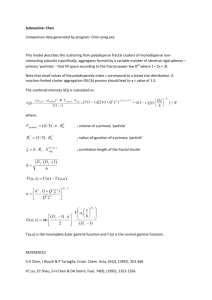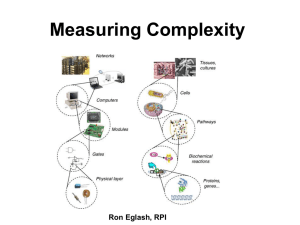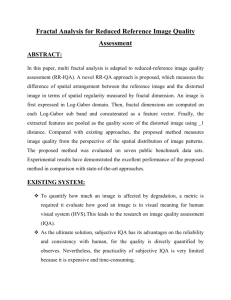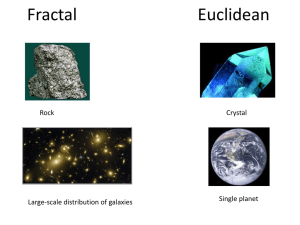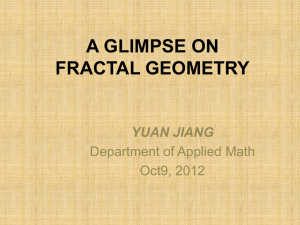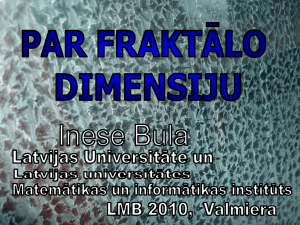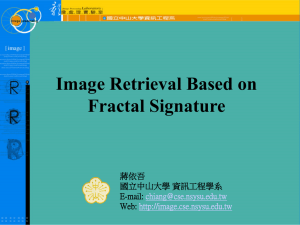Assistant Professor of Biomedical Engineering
advertisement
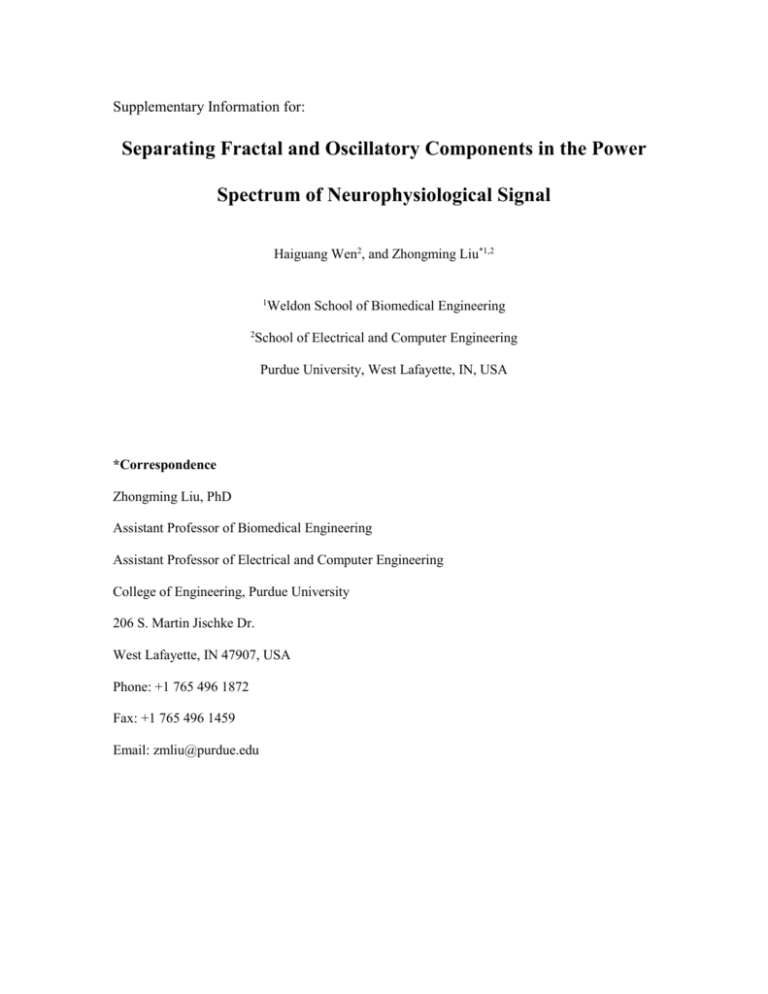
Supplementary Information for:
Separating Fractal and Oscillatory Components in the Power
Spectrum of Neurophysiological Signal
Haiguang Wen2, and Zhongming Liu*1,2
1
Weldon School of Biomedical Engineering
2
School of Electrical and Computer Engineering
Purdue University, West Lafayette, IN, USA
*Correspondence
Zhongming Liu, PhD
Assistant Professor of Biomedical Engineering
Assistant Professor of Electrical and Computer Engineering
College of Engineering, Purdue University
206 S. Martin Jischke Dr.
West Lafayette, IN 47907, USA
Phone: +1 765 496 1872
Fax: +1 765 496 1459
Email: zmliu@purdue.edu
Coarse Graining Spectral Analysis (CGSA)
Yamamoto et al. proposed two versions of CGSA (Yamamoto and Hughson, 1991, 1993).
The 1993 version attempted to address an important limitation of the 1991 version when dealing
with oscillations at multiple harmonic frequencies. A simplified implementation of the 1991
version was described in (He et al., 2010). In addition to the above-mentioned papers, we
elaborate the basis of CGSA and emphasize its limitations as below.
CGSA is based on the same model as IRASA. The model is re-stated as below.
𝑦(𝑡) = 𝑓(𝑡) + 𝑥(𝑡)
(S1)
where 𝑓(𝑡) stands for the fractal time-series component, 𝑥(𝑡) , stands for the oscillatory
component, 𝑦(𝑡) stands the neural signal that sums up these two components in the absence of
noise.
CGSA requires resampling the measured time series signal, 𝑦(𝑡), by a factor of h, resulting in
a new time series, 𝑦ℎ (𝑡), sampled at 1/h times the original sampling rate. To estimate the PSD of
the underlying fractal component (i.e. 𝐹 2 (𝜔)), it was proposed to calculate the cross spectrum of
𝑦(𝑡) and𝑦ℎ (𝑡), denoted as 𝑆𝑦𝑦ℎ (𝜔) (Yamamoto and Hughson, 1991, 1993).
Considering Eq. S1, we can express 𝑆𝑦𝑦ℎ (𝜔) as Eq. S2,
𝑆𝑦𝑦ℎ (𝜔) = [𝐹(𝜔)𝑒 𝑗𝛼(𝜔) + 𝑋(𝜔)𝑒 𝑗𝛽(𝜔) ][𝐹ℎ (𝜔)𝑒 −𝑗𝛼ℎ (𝜔) + 𝑋ℎ (𝜔)𝑒 −𝑗𝛽ℎ (𝜔) ]
= 𝐹(𝜔)𝐹ℎ (𝜔)𝑒 𝑗(𝛼(𝜔)−𝛼ℎ (𝜔)) (1 + Ψℎ (𝜔)𝑒 −𝑗𝜃(𝜔) )(1 + Ψℎ (𝜔)𝑒 𝑗𝜃ℎ (𝜔) )
(S2)
where Ψ(𝜔) = 𝑋(𝜔)⁄𝐹(𝜔), Ψℎ (𝜔) = 𝑋ℎ (𝜔)⁄𝐹ℎ (𝜔), 𝜃(𝜔) = 𝛼(𝜔) − 𝛽(𝜔), θℎ (𝜔) = 𝛼ℎ (𝜔) − 𝛽ℎ (𝜔).
Note that Ψ and θ indicate the relationship between the oscillatory and fractal components in
terms of their ratio in magnitude and their difference in phase, respectively.
If 𝑦(𝑡) only contains the fractal component (i.e. 𝑋(𝜔) and 𝑋ℎ (𝜔) both equal to zero for any
𝜔), the magnitude of the cross spectrum, ‖𝑆𝑦𝑦ℎ (𝜔) ‖, can be simply expressed as Eq. S3,
‖𝑆𝑦𝑦ℎ (𝜔) ‖ = 𝐹(𝜔)𝐹ℎ (𝜔) = ℎ𝐻 𝐹 2 (𝜔) (S3)
If 𝑦(𝑡) only contains a simple oscillation with a single frequency 𝜔0 (i.e. 𝐹 and 𝑋𝑋ℎ both
equal zero for any 𝜔), it is straightforward to show that Eq. S4 holds true.
‖𝑆𝑦𝑦ℎ (𝜔) ‖ = 0
(S4)
It is thus tempting to estimate the PSD of the fractal component by cancelling h with Eq. S5.
𝐹 2 (𝜔) = √‖𝑆𝑦𝑦ℎ (𝜔) ‖ ‖𝑆𝑦𝑦1/ℎ (𝜔) ‖ (S5)
Eq. S5 is central to CGSA in an attempt to estimate 𝐹 2 (𝜔) independent of the resampling
factor h. However, it is important to note that Eq. S5 cannot be generalized to more realistic cases
in which 𝑦(𝑡) includes both fractal and oscillatory components, because the above cross power
spectrum bears very complicated interactions between the fractal and oscillatory components
according to Eq. S2. In the following, we will show that such interactions remain difficult to
eliminate when the cross-spectral analysis is used in an attempt to extract the fractal component.
To start with the perhaps simplest case, we assume that 𝑥(𝑡) is a simple oscillation with a
single harmonic frequency 𝜔0 . Therefore, 𝑋(𝜔) or 𝑋ℎ (𝜔) is non-zero only at 𝜔0 or 𝜔0 ℎ ,
respectively. Based on Eq. S2, we can rewrite ‖𝑆𝑦𝑦ℎ (𝜔) ‖ as
ℎ𝐻 𝐹 2 (𝜔),
𝜔 ≠ 𝜔0 and 𝜔 ≠ 𝜔0 ℎ
𝐻 2 (𝜔)‖1
+ Ψ(𝜔)𝑒 𝑗𝜃(𝜔) ‖,
𝜔 = 𝜔0
𝑆𝑦𝑦ℎ (𝜔) = { ℎ 𝐹
(𝜔)
𝐻 2 (𝜔)‖1
𝑗𝜃
ℎ
ℎ 𝐹
+ Ψℎ (𝜔)𝑒
‖, 𝜔 = 𝜔0 ℎ
(S6)
And the estimate of the PSD of the fractal component is expressed as Eq. (S7).
𝐹 2 (𝜔),
𝜔 ≠ 𝜔0 , 𝜔0 ℎ and 𝜔0 /ℎ
2
(𝜔)‖1
𝐹
+ Ψ(𝜔)𝑒 −𝑗𝜃(𝜔) ‖,
𝜔 = 𝜔0
√‖𝑆𝑦𝑦ℎ (𝜔)‖ ‖𝑆𝑦𝑦1/ℎ (𝜔)‖ =
𝐹 2 (𝜔)√‖1 + Ψℎ (𝜔)𝑒 𝑗𝜃ℎ (𝜔) ‖,
{
𝜔 = 𝜔0 ℎ
(S7)
𝐹 2 (𝜔)√‖1 + Ψ1/ℎ (𝜔)𝑒 𝑗𝜃1/ℎ(𝜔) ‖, 𝜔 = 𝜔0 /ℎ
Eq. S7 suggests that the estimated power spectrum deviates from the scaled power-law
distribution at not only 𝜔0 but also 𝜔0 ℎ and 𝜔0 ⁄ℎ, giving rise to the residual oscillation and the
processing artifact in the estimated PSD of the fractal component (also see Fig. 2 in Yamamoto
and Hughson 1993).
At 𝜔 = 𝜔0 , we can quantify the relative error, denoted as 𝑅𝐸(Ψ, 𝜃), using Eq. S8
𝑅𝐸(Ψ, 𝜃)|𝜔=𝜔0 = ‖1 + Ψ(𝜔0 )𝑒−𝑗𝜃(𝜔0) ‖ − 1 (S8)
This relative error depends on the gross degree of interaction between the oscillatory and
fractal components in terms of their ratio in magnitude and phase difference at 𝜔 = 𝜔0 .
It is worth noting that this error will not vanish by averaging the cross power spectra
estimated from multiple time segments of the original time series (Yamamoto and Hughson,
1991, 1993). In CGSA, one may assume a random phase relationship between the oscillatory and
fractal components. That is, their phase difference 𝜃(𝜔) for any individual time segment follows
a uniform random distribution in [0, 2π]. For the sake of simplicity, let us further assume that
𝐹(𝜔) and 𝑋(𝜔) remain stationary across different time segments. Thus the relative error resulting
from averaging over N time segments can be expressed as
1
−𝑗𝜃𝑖 (𝜔0 )
‖−1
𝑅𝐸(Ψ, 𝜃)|𝜔=𝜔0 = ∑𝑁
𝑖=1‖1 + Ψ(𝜔0 )𝑒
𝑁
(S9)
Given the assumed uniformly random phase distribution, it can be shown that the relative
error does not necessarily converge to zero even with a sufficient number of time segments for
averaging. Instead, it converges to a value that increases with the increasing ratio in magnitude
between the oscillatory and fractal components at 𝜔 = 𝜔0 . The relative error at 𝜔 = 𝜔0 ℎ follows
the similar trend (see the simulation results in Fig. S1).
Moreover, the theoretical limitations of CGSA have more profound effects when the
oscillatory component has multiple harmonic frequencies. This reflects a more realistic
circumstance, as neural signals are rarely strictly sinusoidal with a single frequency. For example,
let us suppose the oscillatory component to have a fundamental frequency at 𝜔0 and a second
harmonic frequency at 2𝜔0 . If one resamples the neural signal by a factor of h=2, the original
oscillatory component and its resampled version overlap in the spectral domain. As a result, their
cross power spectrum is non-zero at the harmonic frequencies, resulting in an even larger relative
error as expressed in Eq. S10 than is expressed in Eq. S8.
𝑅𝐸(Ψ, 𝜃)|𝜔=𝜔0 = ‖1 + Ψ(𝜔0 )𝑒−𝑗𝜃(𝜔0) ‖√‖1 + Ψℎ (𝜔0 )𝑒𝑗𝜃ℎ (𝜔0 ) ‖‖1 + Ψ1/ℎ (𝜔0 )𝑒𝑗𝜃1/ℎ(𝜔0 ) ‖ − 1
(S10)
Importantly, this additional error tends to occur when resampling the signal by an integer
factor (or its reciprocal) and becomes more serious when the oscillatory component has more
harmonic frequencies. A modified CGSA algorithm was proposed to address this problem by
using a phase orthogonalization method (Yamamoto and Hughson, 1993). In this modified
algorithm, the phase of the fractal component is further assumed to be random and uniformly
distributed within [0, 2π], whereas the phase of the oscillatory component is assumed to evolve in
a stationary manner.
It is important to note that the phase orthogonalization method (Yamamoto and Hughson,
1993) is not intended to address or eliminate the interference between the fractal and oscillatory
components. Instead, it attempts to eliminate the cross spectrum between the oscillatory
component and its resample version when the oscillatory component contains multiple harmonics.
Mathematically, let us rewrite Eq. S2 as Eq. S11.
𝑆𝑦𝑦ℎ (𝜔) = 𝐹(𝜔)𝐹ℎ (𝜔)𝑒 𝑗(𝛼(𝜔)−𝛼ℎ (𝜔)) + 𝑋(𝜔)𝑋ℎ (𝜔)𝑒 𝑗(𝛽(𝜔)−𝛽ℎ (𝜔))
+𝐹(𝜔)𝑋ℎ (𝜔)𝑒 𝑗(𝛼(𝜔)−𝛽ℎ (𝜔)) + 𝑋(𝜔)𝐹ℎ (𝜔)𝑒 𝑗(𝛽(𝜔)−𝛼ℎ (𝜔))
(S11)
Obviously, the phase orthogonalization tends to minimize the second term, but does not
necessarily reduce the third or fourth term in Eq. S11. This is in part because the relative phase
difference between the (original/resample) fractal and (resampled/original) oscillatory
components are random and non-stationary. In short, the complex interactions between fractal
and oscillatory components remain problematic despite the use of phase orthogonalization and
impede using the cross-spectral analysis to separate the oscillatory and fractal components as
shown by our simulation results (Fig. 3). Moreover, the aforementioned assumptions for this
phase correction method to be applicable may not be valid in practice and likely confound the
result.
Importantly, though the irregular-sampling technique can successfully remove the oscillatory
component from fractal component in IRASA, the same strategy is not useful in CGSA. This is
mainly because in CGSA the relative errors at the oscillatory frequency, 𝜔0 , are not relocated
with different h values. So for any h value, the cross-spectral power at the oscillatory frequency
always deviates from the power-law distribution, which is an inevitable bias that cannot be
addressed with the same statistical method as used in IRASA (see Fig. S2 for an illustrative
example).
For a fair performance comparison, we employed multiple h values for both the proposed
IRASA method and the modified CGSA (Yamamoto and Hughson, 1993) followed by taking the
median across results obtained with different resampling factors. To quantitatively evaluate and
compare IRASA and CGSA, we defined the percentage error in the estimated power-law
exponent and the mean square error (MSE) in the estimated fractal power spectrum by
using (S12) and (S13), respectively. The power-law exponent was estimated from the slope of
the linear function best fitting the extracted PSD of the fractal component.
𝑒𝑟𝑟𝑜𝑟 =
|𝛽𝑒𝑠𝑡𝑖𝑚𝑎𝑡𝑒𝑑 −𝛽𝑡ℎ𝑒𝑜𝑟𝑒𝑡𝑖𝑐𝑎𝑙 |
𝛽𝑡ℎ𝑒𝑜𝑟𝑒𝑡𝑖𝑐𝑎𝑙
× 100 (S12)
𝑀𝑆𝐸 = avg⟨|log 𝑃𝑆𝐷𝑒𝑠𝑡𝑖𝑚𝑎𝑡𝑒𝑑 − log 𝑃𝑆𝐷𝑡ℎ𝑒𝑜𝑟𝑒𝑡𝑖𝑐𝑎𝑙 |2 ⟩
(S13)
𝜔
As shown in Fig. S3, the relative errors in the estimated fractal PSD and power-law exponent
were both significantly smaller for IRASA than for CGSA. As the number of oscillations
increased, CGSA had a deteriorating performance, whereas IRASA behaved robustly. We also
noticed that the performance of CGSA depended heavily on the phase distribution of the fractal
component. Letting the fractal phase randomly vary from 0 to 𝜃𝑚𝑎𝑥 , we found that the errors for
CGSA increased almost exponentially as 𝜃𝑚𝑎𝑥 became smaller (i.e. the fractal phase became less
random), whereas the performance of IRASA was nearly independent of the range of the fractal
phase distribution. And IRASA is much more robust against the relative amplitude of the
oscillatory component to the fractal component. These simulation results suggest that IRASA is
superior to CGSA.
Fig. S1 Relative error in the estimated power spectrum of the fractal component at frequency 𝜔0 for CGSA (A) The relative error
converges to non-zero values as the number of averages increases. (B) The converged relative error increases with the increasing ratio
in magnitude between the oscillatory component and the fractal component (i.e. Ψ). (C) The relative error also depends on the range
of the phase distribution (i.e. [0, 𝜃𝑚𝑎𝑥 ])
Fig. S2 Extracting the fractal power by using multiple h values in IRASA and CGSA. (A) The simulation signal is composed of a
fractal signal (𝛽 = 1.5, Ψ = 2, 𝜃𝑚𝑎𝑥 = 2𝜋) and an oscillatory signal at 𝜔0 = 20𝐻𝑧. (B) The extracted fractal powers corresponding to
four different h values (1.2, 1.4, 1.6 and 1.8). (C) Estimate the fractal power by taking the median from the power spectra of multiple h
values. Note that in IRASA, the oscillatory power would appear as statistical outliers, the effect of which can be removed by taking
the median. However in CGSA, the oscillatory power would always be present at the oscillation frequency despite the use of different
resampling factors
Fig. S3 Performance evaluation of IRASA and CGSA. (A) Effects of the number of oscillation frequencies (𝛽 = 1.5, Ψ = 1, 𝜃𝑚𝑎𝑥 =
2𝜋), (B) the amplitude ratio of the oscillatory to fractal component (𝛽 = 1.5, N = 10, 𝜃𝑚𝑎𝑥 = 2𝜋), and (C) the range of the fractal
phase distribution (𝛽 = 1.5, N = 10, Ψ = 1), on the errors in the estimated power-law exponent (𝛽) (top) and the estimated power
spectrum of the fractal component (bottom)
